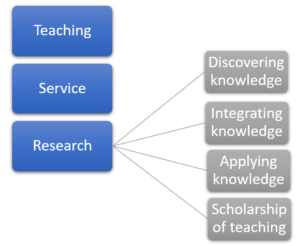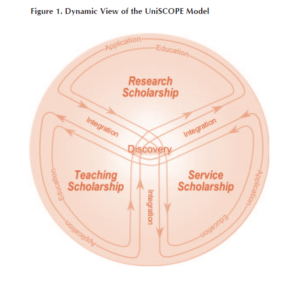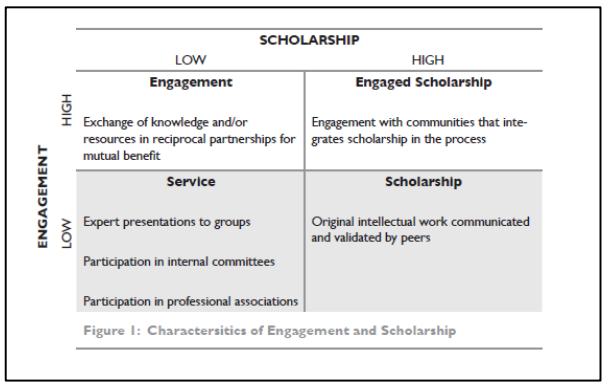Details and Examples
Introduction
Introduction
University Policy #4340 (Faculty Tenure and Promotion Guidelines) defines four types of scholarship based on the Boyer model:
4.2.2B Scholarly, Creative, or Research Activities
For the purpose of promotion and tenure Boise State University recognizes the Boyer model of scholarship, while expecting recognition of such work through peer review. This model identifies four types of scholarship: (1) discovering knowledge, (2) integrating knowledge, (3) applying knowledge, and (4) scholarship of teaching. While faculty are free to pursue each of these types of scholarship at Boise State University, colleges and departments may choose to focus their efforts on one or more of these types. Any college or departmental focus must be identified in the respective college and/or department tenure and promotion guidelines.
Several department and/or college tenure and promotion policies recognize and reward these types of scholarship, but not all do for a variety of reasons. Now more than ever we are witnessing faculty engaging in the scholarship of application and engagement, in particular, even though they may not recognize their work as such. We would like to capture the range and diversity of scholarly and creative activities emerging in response to pandemic conditions and support faculty in determining which may reflect the standards for scholarly and creative work that Ernest Boyer defined and that numerous institutions have adopted.

The Boyer Model of Scholarship can be applied in a myriad of ways, and Boise State’s approach focuses on defining the category of research and creative activity in terms of the four different types of scholarship Boyer describes, as shown in the following diagram.
However, other institutions have applied the Boyer model of scholarship to define the whole of faculty work, not just one part of the traditional triumvirate, thus redefining the work of the professoriate. Take, for example, this UniSCOPE model of scholarship from “Beyond Boyer: The UniSCOPE Model of Scholarship for the 21st Century“:

Figure 1 depicts a dynamic view of the four functions of scholarship in relationship to the three forms. The arrows depict the flow of knowledge from discovery and integration to society through education and application. It also shows that application and education, in turn, may lead to the discovery of new knowledge and its integration into one or more forms of scholarship. The UniSCOPE model of scholarship is thus a continuously iterative process wherein the knowledge and creativity of the academy are brought to the field and are, in turn, reinvigorated in the processes of application, education, and integration.
Standards for Scholarly and Creative Work (Boyer)
These standards are widely used to evaluate scholarly and creative work across the country. Although these standards are not explicitly called out in Boise State’s policies beyond the requirement of peer review, many will recognize them as central to the scholarship of discovery with which most of us are familiar. These standards cut across all four of the Boyer categories and can be used to assess scholarly and creative work.
- clear goals
- adequate preparation
- appropriate methods
- significant results
- effective presentation
- reflective critique
- Public dissemination
- Peer reviewed
For a more detailed discussion, see A Framework For Community Engaged Scholarship
Poggenpohl, Sharon. (2015). Communities of Practice in Design Research. She Ji: The Journal of Design, Economics, and Innovation. 1. 10.1016/j.sheji.2015.07.002.
Traditional models of scholarly and creative activity–the scholarship of discovery–separate the activities of teaching and service from scholarly or creative expertise and standards. Increasingly, however, institutions have come to recognize the intersection of “teaching” with the scholarship of teaching and learning. As important are the intersections of “service” with the scholarship of application and the scholarship of integration (sometimes referred to as the scholarship of engagement, outreach scholarship, community engagement, etc.). When a faculty member’s disciplinary expertise is brought to bear on initiatives that serve the community, the profession, or the university, the work may have a scholarly dimension that is evident in the approach to the task, the results of the service (products, policies, organizations, etc.), or in work that feeds back into the discipline (new areas of research, or new approaches to teaching or scholarship, etc.). Scholarly and creative activities that fall under the categories of application or integration include applied research, policy analysis, technical assistance, technology transfer, and activities undertaken with a goal of building community capacity and competency. When a faculty member is engaged in the transmission of knowledge to public community members, as a representative of the academic community, that work can fall within teaching, application, or integration.
Adapted from Examples For Documenting And Evaluating Faculty Service Office Of Academic Affairs P&T Resource MAY 30, 2005 by Susan B. Hannah, Vice Chancellor for Academic Affairs, Indiana University – Purdue University – Fort Wayne
Figure 1 illustrates how to distinguish whether an activity falls under engaged scholarship (another term for the scholarship of application), service, or the scholarship of discovery.

Franz, Nancy K., “Tips for Constructing a Promotion and Tenure Dossier that Documents Engaged Scholarship Endeavors” (2011). Education Publications and Papers. Paper 1. http://lib.dr.iastate.edu/edu_pubs/1
Example of Boyer Model: Long, Billy. “The Tenure Process in Higher Education: An Application of the Boyer Model of the Professoriate to Create a Coherent Record of Scholarly Productivity” International Journal of Humanities and Social Science Vol 4, No. 9; July 2014: 43-50.
What Makes An Activity “Scholarship”?
The following list of characteristics of scholarship is adapted from Recognizing Faculty Work, by Robert Diamond and Bronwyn Adam (1993):
- The activity requires a high level of discipline expertise.
- The activity breaks new ground or is innovative.
- The activity can be replicated and elaborated.
- The work and its results can be documented.
- The work and its results can be peer reviewed.
- The activity has significance or impact.
More simply stated, scholarship is work that is public, peer reviewed and available in a platform that others may build on. Faculty take a scholarly approach when they systematically design, implement, assess and redesign an activity, drawing from the literature and best practices in the field (Association of American Medical Colleges, Advancing Educators and Education: Defining the Components and Evidence of Educational Scholarship).
Scholarship is, at its heart, about contributing to a body of knowledge. Such contributions could be in the form of the creation of new knowledge or the dissemination of knowledge.
Creation of knowledge is not just research. Integrating existing knowledge in new ways, making linkages, applying knowledge in new ways, or coming up with new methods would also be considered part of creating knowledge. Simply conducting a research project might not be considered scholarly unless the project results are documented, able to be reviewed by peers (including practitioners, policy makers, community members, etc. if appropriate) and disseminated.
Dissemination is not just publishing. It is teaching and consulting, community talks, legislative testimony, media presentations, etc. Dissemination is about putting knowledge in the public domain.
From the COMMUNITY-ENGAGED SCHOLARSHIP TOOLKIT, developed by Calleson D, Kauper-Brown J, Seifer SD., Community-Campus Partnerships for Health
Examples of Evidence for Each of the Boyer Models for Scholarship
Caveats
To fall within the general category of scholarly/creative activity, the activity is expected to meet these standards:
- clear goals
- adequate preparation
- appropriate methods
- significant results
- effective presentation
- reflective critique
- Public dissemination
- Peer-reviewed (as defined within discipline and appropriate for the scholarly/creative activity)
Adapted from Examples For Documenting And Evaluating Faculty Service Office Of Academic Affairs P&T Resource MAY 30, 2005 by Susan B. Hannah, Vice Chancellor for Academic Affairs, Indiana University – Purdue University – Fort Wayne
The purpose of defining these types of scholarly/creative activity is illustrative, not definitive.
The Scholarship of Discovery/Discovering Knowledge
- the pursuit of new knowledge; original research or creative scholarship
- Search for new knowledge
- Traditional definition of scholarship
- Discovery of new information and new models
- Sharing discoveries through scholarly publication
- “..the commitment to knowledge for its own sake, to freedom of inquiry”
Examples of the Scholarship of Discovery
- Publication of original research in the discipline and related interdisciplinary fields of study published in the form of a monograph, refereed journal article, plays, book, book chapter or in a collection of essays by an appropriate press (excluding vanity presses).
- Dissemination of original research through a paper or lecture given at a meeting or conference; through a museum exhibit or other project or program; or presented in a contract research report, policy paper or other commissioned study.
- Stage directing and production of plays (theatrical productions) with reviews.
- Performances, exhibitions, and presentations at well recognized venues with reviews.
- Production of films/documentaries, written plays with reviews.
- Books of poetry/poetry collections, novels, and anthologies with reviews.
- Documentary edition.
- Critical edition.
- Seeking and/or securing extramural grants.
- Direction of graduate student and undergraduate student research.
- Internally or externally funded research projects
The Scholarship of Teaching
- Involves the search for innovative approaches and best practices to develop skills and disseminate knowledge.
- The act of teaching as well as the planning and examination of pedagogical procedures
Examples of Scholarship of Teaching
- Technical, procedural or practical innovations made clinically or professionally
- Educational research projects resulting in findings disseminated at professional conferences and/or in peer-reviewed publications
- Grant applications and extramural funding for innovative teaching methods, to support instructional activities.
- Direction of graduate and undergraduate student research.
- Development, revision and assessment of curriculum.
- Community based and/or off-campus teaching.
- Development of visual and other teaching materials (including edited anthologies, textbooks and software) implemented in the classroom or disseminated through publications, papers or non-print form, including the production of videos for instruction
- Student and peer groups’ evaluations.
- Direction of student internships.
- Advising and tutoring of students.
- Consultation within/outside the academic community on pedagogical issues, etc.
- Museum exhibitions, catalogues, lectures, lms, radio, etc. (public programs as a form of teaching).
- Global education/Faculty Led Study Abroad
Scholarship of Teaching: Examples from Boise State Faculty
- “Predict and protect: anthropology student maps cultural heritage sites”
- “Videos available to help students hone critical skills in an era of misinformation”
- “Disruption sparks innovation: professors go digital for their students”
- “Kinesiology department partners with Children’s Center to study motor development skills”
- “Studio art professors teach hands-on skills in a remote new world”
The Scholarship of Application/Applying Knowledge
Also called the scholarship of engagement. See Community-Engaged Scholarship Toolkit for more specific examples and frameworks for evaluating.
- Using knowledge responsibly to solve consequential problems, especially those that affect on-campus communities and society as a whole; knowledge that arises out of the very act of application. See Boise State’s Service Learning resources on engaged scholarship.
- Discovering ways that new knowledge can be used to solve real-world problems.
Examples of Scholarship of Application
- Support or development of community activities in the field or industry that link with academic discipline
- Formal development and /or oversight of practica/partnerships on behalf of the University that connects students with the field/industry
- The application of theory in the field to real-world problems.
- Development of centers for study or service
- Publication of textbooks or methodological studies.
- Stage directing and production of plays (theatrical productions) with reviews.
- Performances, exhibitions, and presentations at well-recognized venues with reviews.
- Production of films/documentaries, written plays with reviews.
- Books of poetry/poetry collections, novels, and anthologies with reviews.
- Public programming (exhibitions) in museums and other cultural and educational institutions.
- Consulting activities in field or industry that directly relate to the intellectual work of the faculty member (e.g., Consulting and providing expert testimony on public policy and other matters.)
- Contract research on policy formulation and policy outcomes.
- Participation in film and other media projects.
- Writing and compiling institutional and other histories.
- Administration and management of professional organizations.
- Presentations at instructional workshops.
- Review of manuscripts and grant applications.
- Service as an external reviewer for pre-tenure review, tenure, and promotion files.
- Advising student organizations within the discipline.
- Professional service (editing of journals and newsletters, organizing scholarly meetings, serving on boards of professional associations, chairing or serving on book prize or fellowship committees, etc.).
- Grant applications and external funding.
- Community service drawing directly on scholarship through service on state humanities councils, presentation of public lectures, etc.
- Global Education/Faculty Led Study Abroad
Scholarship of Application: Examples from Boise State Faculty
- “Biden’s big night with moderates, African Americans and baby boomers” section by Matthew May
- “Help Albertsons Library document COVID-19 history at Boise State”
- “Education faculty creates trademarked bullying intervention program”
- “Boise State research increases teacher retention rates in Idaho”
- “Protecting Boise’s vulnerable communities with stylish sewing”
- “European Commission Energy Webpage”
- “Respiratory care faculty rapidly respond to meet public health needs”
The Scholarship of Integration/Integrating Knowledge
- Interpretation, synthesis, and bringing new insights to original research or creative scholarship
- Integration of knowledge from different sources
- Presents an overview of findings in a resource topic
- Bringing findings together from different disciplines to discover convergence.
- Identify trends and see knowledge in new ways.
- “Bringing insight to bear on original research” with “interpretive, integrative, interdisciplinary” approaches.
Examples of Scholarship of Integration
- Publication of synthetic research in the discipline and related interdisciplinary fields of study, including book-length (such as textbook) or shorter syntheses, methodological studies, integrative essays, review essays, and encyclopedia entries.
- Dissemination of synthetic or integrative research through a paper or lecture given at a meeting or conference; through a museum exhibit, film, or other public programs; or presented in a contract research report, policy paper, or other commissioned study.
- Publication of anthologies, journals, or collections (such as an edited collection or monograph series) comprised of the work of other scholars.
- Publication of book reviews, literature reviews.
- Non-academic publications that address discipline-related concerns
- Meta-analysis (contrasting or combining results from different studies)
- Commentary on original or synthetic research at conferences.
- Professional development workshops
- Presentation of Departmental or University activities at pedagogical conferences, etc.
- Membership on advisory boards within/outside the academic community.
- Participation in professional organizations, meetings.
- Grant applications and extramural funding.
Scholarship of Integration: Examples from Boise State Faculty
Examples/Definitions from Various Disciplines
(under construction)
- Defining Scholarship for the Discipline of Nursing from the American Association of Colleges of Nursing (includes standards for each type of scholarly activity)
- Promoting Applied Scholarship for Tenure & Promotion (Anthropology)
- Community-Engaged-Scholarship-in-Business-Economics
- Report of the MLA Task Force on Evaluating Scholarship for Tenure and Promotion
- Tenure, Promotion, and the Publicly Engaged Historian
Tips and Toolkits
Calleson D, Kauper-Brown J, Seifer SD. Community-Engaged Scholarship Toolkit. Seattle: Community-Campus Partnerships for Health, 2005. compact.org/resources/the-community-engaged-scholarship-toolkit
Connecticut Campus Compact Engaged Scholarship Advisory Committee. Framework for Community Engaged Scholarship. Connecticut Campus Compact. Fairfield, CT: Connecticut Campus Compact, 2012.
Franz, Nancy K., “Tips for Constructing a Promotion and Tenure Dossier that Documents Engaged Scholarship Endeavors” (2011). Education Publications and Papers. Paper 1.
Glass, Chris R.; Doberneck, Diane M.; and Schweitzer, John H., “Unpacking Faculty Engagement: The Types of Activities Faculty Members Report as Publicly Engaged Scholarship During Promotion and Tenure” (2011). Educational Foundations & Leadership Faculty Publications. 2.
digitalcommons.odu.edu/efl_fac_pubs/2
Jordan C (Editor). Community-Engaged Scholarship Review, Promotion & Tenure Package. Peer Review Workgroup, Community-Engaged Scholarship for Health Collaborative, Community-Campus Partnerships for Health, 2007.
NIH Community Engagement Framework for Peer Review Guidance
Example of Engaged Scholarship Checklist Form
